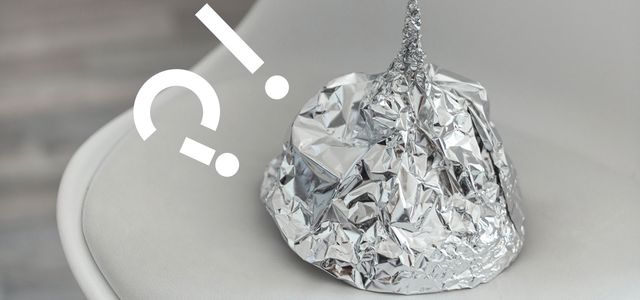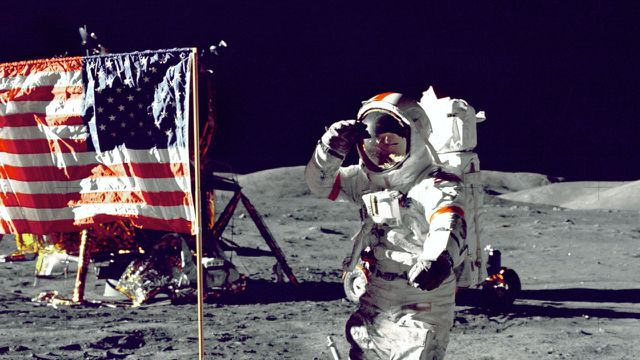
The USA faked the moon landing in the film studio, the city of Bielefeld does not exist and the corona virus was developed to suppress humanity: conspiracy theories are booming again – but what is the common factor?
The aluminum hat has become a symbol for conspiracy theorists: You wear a light metal cap to protect your own brain (originally against “telepathy” – in a science fiction story from 1927). Few people today seriously wear an aluminum hat – but the term has become a metaphor for conspiracy theorists.
Actually, this is a friendly, almost affectionate term, because by no means all conspiracy theories are harmless, and paranoia is increasingly used to make politics. But World improvers should believe in a better world – not because somewhere a group of the world’s worst wants to destroy everything.
So we tried to find out how to identify conspiracy theories. It’s not easy!

Not a single astronaut has ever questioned the moon landing – yet many doubt that a person ever stepped on the moon. (Photo: nasa / unsplash.com)
Indication 1: conspiracy theories contradict common belief
Conspiracy theories mostly swim against the current and contradict the “mainstream”. Example: The terrorist attacks of September 11, 2001. The perpetrators have been identified and the process is clear – but conspiracy theorists offer something they think is better: “alternative” explanations. Accordingly
- the US government approved the attacks
- or the government even (and with the help of the CIA) carried out the attacks on its own people
- and in general the buildings did not collapse because of the planes hitting them, but (depending on the V theory) through energy weapons or small atom bombs …
Why do we remember the very special people, things and events better than the average, the normal, the everyday? Because they stand out from the crowd, are unusual and swim against the current.
This is also an indication of conspiracy theories: they offer an astonishing, indeed unbelievable, different view of things – and only for this reason do some find them particularly credible. They just stick better in your head.
A strong indication – but one with a catch: Because as an open society, we must also be allowed to question things. For example, much of what physicists and doctors believed in past centuries later turned out to be “wrong”. Yes, but that was by no means a conspiracy! Examining theses is part of the nature of enlightened science.
In the case of the Corona virus, some aluminum hats consider it suspicious that virus experts who today issue strict warnings about loosening had viewed Corona as a minor problem weeks ago. Is this a sign of a conspiracy that they disagree today – or just that you know more today than you did at the beginning of the year? The current world declaration is only valid until a better one is available. For example, Isaac Newton’s great physics is actually “wrong” in several places. And yet we learn it at school before Einstein’s “more correct” physics, simply because it is much easier to use – and sufficient for many purposes.
Indication 2: Conspiracy theories offer simple explanations
Our brain is a system that tries to recognize patterns in everything. Two dots and a dash below it – we recognize a smiley. Two pictures in a comic – our brain fills the gap in between. That’s how we are, and in everyday life that’s a mostly useful skill. We are trained to fill things we don’t know with speculations based on what we know.
Therefore, everything is welcome that gives us an explanation: “Stripes in the sky are suddenly“ chemtrails ”- instead of one of many complicated weather phenomena that you would understand if you were a meteorologist. Corona is then a targeted attack on our freedom – and not a virus like many before that, which exist in various threats (measles, rubella, HIV, Ebola) and which belong to all life on earth, which you would understand if you were would be a virologist.



Many conspiracy theories are currently circulating around the corona virus. (Photo: napendra singh / unsplash)
Indication 3: conspiracy theories define enemy images
The Freemasons. The Illuminati. The Russians. The Chinese. The American. The bankers. The corporations. The doctors. The journalists, especially in the “mainstream media”. And of course the politicians. There are always conspirators who can be clearly identified – and they are always “the others”.
This is also a clear indication of a conspiracy theory: It starts from a group of conspirators who want to assert interests that run counter to those of society (well: mostly mostly those circles to which the conspiracy theorists feel they belong).
As early as the 14th century there was the so-called plague pogrom, in which the Jews were particularly hostile and murdered in parallel to the spread of the plague. They were accused of poisoning wells to spread the plague. However, some of the pogroms took place before the respective region was hit by the plague – this is reminiscent of the pegida, which is particularly strong in those countries that have little migration.
Today, the hostile conspirator can be recognized above all by the fact that he is powerful: the other superpower, his own government, the corporations, the Vatican – or simply: “those up there”. This is why so many conspiracies allegedly originate from the superpower USA – the dwarf state Tuvalu has never been conspicuous about conspiracies.
People obviously prefer to believe that a secret power is pulling the strings in the background. They don’t want to believe that no threads are pulled at all and that big events have a variety of causes – but rarely put conspirators behind it. And yet there is a grain of truth in some suspicions, because of course the secret services of all powerful nations have always intervened in the fate of the world.
Indication 4: Experts ignore conspiracy theories
A study Kent University examined the differences between people who subscribe to conspiracy theories and those who reject them. So have Conspiracy theorists have a tendency to question the “official version”. Since the official version is mostly the one that is distributed by authorities (state, media, experts), it is in the nature of conspiracy theory to ignore all of them.
Corona and the climate therefore have a number of voices that seem to contradict the mainstream – but that, on closer inspection, they are not experts, rarely bothers conspiracy theorists. Also, not a single astronaut has ever questioned the moon landing (not even Russian cosmonauts) – yet many doubt that anyone ever stepped on the moon. Buzz Aldrin, the second man on the moon after Neil Armstrong, therefore ripped 2002 even the thread of patience and he knocked in a conspiracy theorist. This is not necessarily the way we should deal with open society, but it is also something that is typical of conspiracy theorists: arguments are hardly accessible anymore.



Conspiracy theories offer simple explanations: “Stripes in the sky are suddenly” chemtrails “(Photo: naomi tamar / unsplash.com)
Indication 5: conspiracy theories are entertaining
The Flat Earth Society has been seriously believing for over 50 years that the earth is flat – and a worldwide conspiracy would only convince the rest of us of the “globe”. According to another theory, the Nazis are said to have emigrated to the moon with the help of so-called “Reichsflug Disks” – still others believe that they live in the middle of the earth because it is hollow.
As if that weren’t enough, Angela Merkel is supposedly Hitler’s daughter, and her hands folded into the “Merkel-Rhomb” are (by the way, as with pop star Beyoncé!) A reference to the Illuminati, a secret order that has been allegedly the thread for centuries in the background pulls … yes, google it, you’ll be surprised!
Not everyone has to find all this nonsense entertaining. But the Incredible-but-true factor turns such nonsense into great stories to tell. Accordingly, there are hundreds of books on conspiracy theories, critical and non-critical, plus series and films …
Indication 6: Conspiracy theories do not accept evidence to the contrary
Science works like this: One proposes a thesis, namely that all things fall to the ground equally quickly. That we experience it differently in everyday life, for example with a spring and a hammer, and of course there are reasons (the air resistance). You can test this thesis: You switch off the interference factor “air resistance” and drop the hammer and spring in a vacuum (!) At the same time. And, as most of you may have experienced in class, both objects actually fall to the ground just as quickly. By the way, this was 1971 also checked again on the moon, on which nobody allegedly landed …
If a physicist had observed that the spring falls slowly even in a vacuum, he would have reformulated the corresponding natural laws. Because that’s the whole point of science: to describe the world as it is. Only then can you derive predictions from natural laws or otherwise intervene practically in the course of the world.
Conspiracy theorists, however, persist in their belief no matter how much you contradict them. The question for them should therefore be: What actually has to happen so that you no longer believe in your conspiracy? (Incidentally, everyone can ask the question themselves!) Is the answer: No matter what happens, it’s just further evidence of the conspiracy itself!, then we just have an aluminum hat on.
Take the moon landing, for example: If at least Aldrin or Armstrong and the Russians would say that the moon landing was a fake, then it probably was. But conspiracy theorists rarely express such clear expectations. And what would have to happen so that nobody believes what Donald Trump is currently spreading, namely that the corona virus somehow comes from a Chinese laboratory? Unfortunately, nothing can happen there… because “proof” that the virus comes from nature is so difficult to provide that it will not exist.
Indication 7: conspiracy theories presume immense effort
Most conspiracy theories assume that the conspirators have almost unlimited resources. Let’s take the theory that someone would want to restrict the freedom of democratic states with the Corona virus and imagine the effort.
You don’t brew a virus like this in the back room, you need laboratories, money, a lot of employees, educated experts. They should be behind the project – but generally educated people rarely have the desire to destroy another part of the world. And even if there is, there will always be dissatisfied people (bad pay, bad laboratory canteen, lousy superiors) who leak something … in short: the more complex a project, the more difficult it is to keep it secret.
Film tip: “Company Capricorn” from 1978, in which NASA space travelers have to pretend that they landed on Mars – but they are not. The film in no way intends to support the moon landing conspiracy theory. Rather, it shows how difficult it would be to keep such a secret permanently.
Another indication: you can make money with conspiracy theories
The credo of many conspiracy theorists is: Cui bono – who benefits? This is how they substantiate the thesis that the CIA or the US arms industry collapsed the Twin Towers in order to make money from the war in Iraq and Afghanistan.
One can ask: Who benefits from all the conspiracy theories? Above all, the conspiracy theorists themselves, because you can also make money with all the claims, Selling books, running websites with advertising, giving lectures, chatting on YouTube channels and much more, recently also doing populist politics.
Particularly blatant example: According to a conspiracy theory, barcodes, i.e. the barcodes on many products, pose a great danger. Exactly how the danger looks is always vague, but “negative energies” are involved …
Remedy: The barcode must be crossed out! And that with a special “barcode suppression pin” – for around 10 euros. Needless to say, any other pen (or aluminum hat) would have the same effect – namely none.
Read More:
- Climate change facts: 7 climate denier arguments in the fact check
- The power of science – and why it’s okay when experts contradict each other
- Six meaningful ideas for everyday corona
- The imperfect happiness – or why we now run into the void with perfect self-optimization
You might also be interested in these articles
-
Forest and health: 8 amazing facts
-
7 clues from which you can identify a conspiracy theory
-
We should save these seven climate terms in the future
-
Before it’s too late: 10 things you should convince your parents about
-
Brain researcher Gerald Hüther: “Life is not about fulfilling any consumption needs”
-
Movie tip: 2040 – We save the world
-
Unfortunately true: 9 pictures about the lousy ideals of our society
-
Everyday racism: When it wasn’t meant to be bad
-
Special report of the Intergovernmental Panel on Climate Change: one catastrophe a year